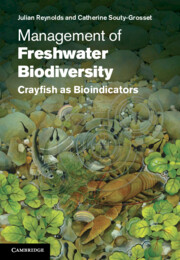Book contents
- Frontmatter
- Contents
- Preface
- Acknowledgements
- Introduction: Biodiversity in freshwater systems, and the key roles played by crayfish
- Part I The present situation of crayfish in world freshwater ecosystems
- Part II Applying science to conservation management
- A Protecting freshwater biodiversity through monitoring and conserving crayfish
- 6 Understanding and managing biodiversity using crayfish
- 7 Monitoring in conservation and management of indigenous crayfish populations
- B Management for conservation
- Part III Knowledge transfer for successful crayfish management
- References
- Glossary
- Index
- Scientific and common English names of well-studied crayfish featured in this book
- Common English and scientific names of well-studied crayfish featured in this book
- Plate section
6 - Understanding and managing biodiversity using crayfish
from A - Protecting freshwater biodiversity through monitoring and conserving crayfish
Published online by Cambridge University Press: 05 December 2011
- Frontmatter
- Contents
- Preface
- Acknowledgements
- Introduction: Biodiversity in freshwater systems, and the key roles played by crayfish
- Part I The present situation of crayfish in world freshwater ecosystems
- Part II Applying science to conservation management
- A Protecting freshwater biodiversity through monitoring and conserving crayfish
- 6 Understanding and managing biodiversity using crayfish
- 7 Monitoring in conservation and management of indigenous crayfish populations
- B Management for conservation
- Part III Knowledge transfer for successful crayfish management
- References
- Glossary
- Index
- Scientific and common English names of well-studied crayfish featured in this book
- Common English and scientific names of well-studied crayfish featured in this book
- Plate section
Summary
Background to freshwater biodiversity and the role of crayfish
Some background to current ideas on biodiversity is provided in the Introduction to this book and developed with relation to aspects of crayfish ecology in Chapter 3. The pool of living diversity is dynamic, with continual changes in genetic variation, community structure and function. However, the biodiversity of an area is not just the sum of species present; for many organisms, particularly among the small and often unrecognized forms collectively known as ‘cryptobiota’ (Good, 2009), the relevant habitat or community is small or restricted. Also, introducing an extra species to a community does not necessarily increase biodiversity, and may often deplete it. Here we examine the value of biodiversity, the impact of changing freshwater systems on biodiversity, and the relationships of freshwater decapods, particularly crayfish, to community biodiversity.
As was mentioned in the introductory chapter, biodiversity in fresh waters is enormous in relation to the global extent of surface waters. Fresh water is also very fragmented and unevenly distributed across the globe, with a range of consequences for biodiversity (Saunders et al., 1991). The extensive literature on biodiversity and habitat fragmentation can generate different conclusions depending on how species richness is measured, and whether the fragmentation reflects habitat loss or its subdivision (Fahrig, 2003). Much of the diversity of catchments may lie outside the main channels, in marshes, ditches and individual small ponds. Some organisms (including some freshwater decapods) are characteristic of such wetlands and marshes, while others are largely restricted to rivers, streams and/or small lakes.
- Type
- Chapter
- Information
- Management of Freshwater BiodiversityCrayfish as Bioindicators, pp. 149 - 168Publisher: Cambridge University PressPrint publication year: 2011
- 1
- Cited by

